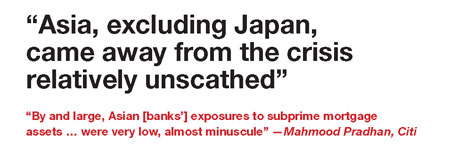EM REGIONAL BANKING FOCUS: ASIA
By Michael Shari
A consistent focus on traditional-style banking has enabled Asia’s financial giants to emerge from the recent crisis in fine fettle.

On any given day at Shanghai Pudong International Airport, squadrons of arriving bankers board waiting fleets of taxis that ferry them onto an elevated highway to the financial Mecca of emerging Asia. En route they pass an eerie reminder of the mortgage crisis that wiped Wall Street’s balance sheets clean a couple of years ago—block after block of new, empty apartment buildings without curtains or a stick of furniture visible through the windows.
But this is one property boom that is unlikely to beleaguer lenders, according to senior officials of the International Monetary Fund and analysts at several investment banks and asset management firms. In a country with the world’s largest population (1.3 billion people) and highest household savings rate (38%), the middle class is simply moving its savings from bank accounts to real estate. Most buyers are paying 50% down payments for second homes that they are keeping empty to sell later, and some are paying entirely in cash, says Nicholas Yeo, head of China equities at Aberdeen Asset Management in Hong Kong.
And so it goes for Asia’s emerging markets, where banks tend to be better capitalized and less exposed to high-risk assets than their American and European peers. “Asia, excluding Japan, came away from the crisis relatively unscathed,” says Mahmood Pradhan, a senior adviser to the Asia and Pacific department of the IMF in Washington. “By and large, Asian [banks’] exposures to many of the assets that were written down substantially in value, such as subprime mortgage assets … in the US, were very low, almost minuscule.”
The region’s banks had long since learned their lesson in the Asian financial crisis of 1997–1998, when they were forced to write down hundreds of billions of dollars in real estate assets. They spent years rebuilding their capital under heightened regulatory supervision, carving out nonperforming loans and merging with each other. “The transformation has been very profound,” says Bill Stacey, a banking analyst at Keefe, Bruyette & Woods in Hong Kong.
One of Asian banks’ greatest strengths is that they are primarily commercial banks—not investment banks—and they generate about 80% of their revenue from interest income on the spread between deposit rates and loan rates, estimates Frederick Jiang, portfolio manager of the Ivy Pacific Opportunities Fund at Waddell & Reed in Overland Park, Kansas. In stark contrast, American and European banks derive about half of their revenue from investment banking. “Asian banks were not under the same pressure from their shareholders as US and European banks were to go looking for high-yielding assets, largely because they were able to generate sufficient income from traditional lending activities within Asia,” says the IMF’s Pradhan.
China Merchants Bank, a Shenzhen-based lender with $380.7 billion in assets, gets high marks for credit quality because it is more selective than its competitors in screening loan applications, it has never required a government bailout, and it is not state-owned, says Waddell & Reed’s Jiang. CMB derives 37.5% of its operating income from retail banking, a high-margin business in which CMB is taking the lead in the domestic market. CMB has a nonperforming loan ratio of just 0.8%, among the lowest in China.
Regional Growth
In India, Housing Development Finance Corp., a low-cost mortgage lender, lays claim to nearly 100% of the mortgage market in the world’s second most populous country (1.2 billion people). Mortgage penetration is low in India at less than 8% of GDP, while the savings rate is high at 34.7%. “There is a lot of room to grow,” says Aberdeen’s Yeo.
In Indonesia, Bank Rakyat Indonesia has a vast reach across the world’s fourth most populous country and specializes in the high-margin business of small loans for small and medium-size enterprises. In many of the remote villages that are home to the majority of Indonesia’s 238 million people, BRI has the only bank branch, and “the manager knows all the borrowers very well,” says Jiang. Jiang estimates the spread between BRI’s lending and deposit rates at 11% to 12%. Its ROE is 28.5%, which is 7.4 percentage points above average for an Indonesian bank.
The region has some of the highest loan growth rates in the world—more than 20% a year in India, about 15% in China and about 20% in Indonesia, by Waddell & Reed’s estimates. That spells tremendous growth potential for the region’s asset base, which was about $24 trillion, or just over half the size of the US asset base, at the end of 2009, according to estimates by Keefe, Bruyette & Woods and the Federal Reserve Board. More than two-thirds of loans are commercial, and less than a third are consumer, according to Waddell & Reed. As a result, these banks enjoy a high average ROE of 22.9% in China, 21.3% in Indonesia, 16.7% in India and 12.2% in Korea, according to Citigroup.

Suffice it to say emerging Asia’s banks are also better prepared than their Western counterparts to follow new rules announced last month by the Basel Committee on Banking Supervision. The average Tier 1 capital ratio for banks in China, Hong Kong, India, Indonesia, Korea, Malaysia, Pakistan, Singapore, Taiwan and Thailand is 10.7%, according to Citigroup. That average comfortably exceeded the 4% ratio required under the old Basel II rules. Under the new Basel III rules, the definition of Tier 1 capital was tweaked to be more conservative, and the Tier 1 requirement was raised to 6%.
One lingering concern is the potential impact of political lending for infrastructure projects in China. Last year a government order to help stimulate the economy led banks to issue $1.4 trillion in new loans, some of which went into new toll roads, airports and other projects. The economy grew at a breathless clip of 8.7% in 2009, and the government responded with a more modest lending quota of $1.12 trillion for 2010. But then a preliminary study by the lenders themselves warned that more than 20% of their $1.4 trillion in outstanding loans to the country’s local governments were teetering toward default. “Some of these projects may not be financially viable in the long term, even though they’re done in the name of stimulating the economy,” explains Aberdeen’s Yeo. Now the China Banking Regulatory Commission is reportedly considering raising provisions for nonperforming loans.
No one is suggesting that China’s banks will have any difficulty raising equity, though. In July, Agricultural Bank of China raised a staggering $22.1 billion in what was the world’s largest IPO ever. Subsequently, Industrial and Commercial Bank of China, China Construction Bank, and Bank of China announced plans to raise more than $30 billion in the months to come.
Across emerging Asia, as long as they are measured against their American and European peers, the leading banks of the region can be expected to come out smelling like roses for the foreseeable future. “The Asia names look really strong now,” says KBW’s Stacey.


